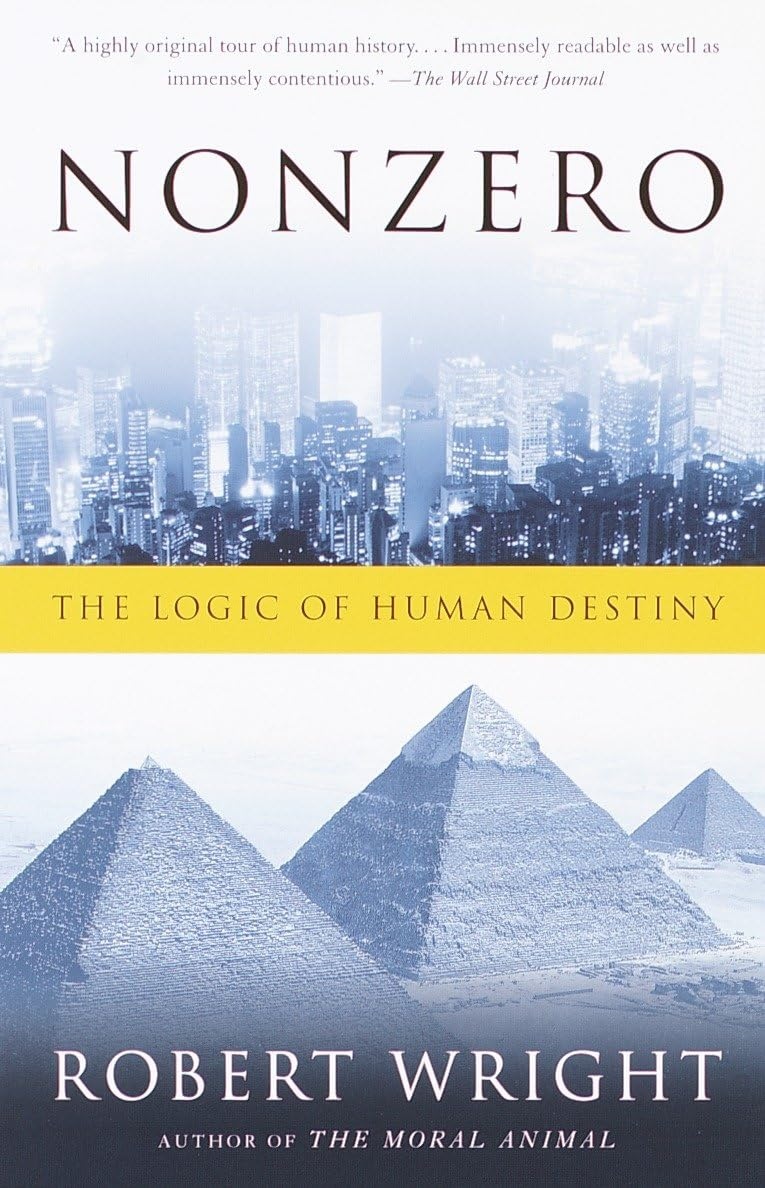
Nonzero: The Logic of Human Destiny by Robert Wright takes us from the first forms of life to our modern world. It shows how biological evolution and cultural evolution have followed parallel paths from hunter gatherer societies, through the industrial revolution, to the information age. This is a great compliment to the way history is generally taught in schools and belongs in every school library.
Introduction: The Storm Before the Calm
- About fifty years ago John von Neumann and Oskar Morgenstern invented game theory. They made the distinction between “zero-sum” and “non-zero-sum” games. In zero-sum games, the fortunes of the players are inversely related. In games like tennis, chess, and boxing, one contestant’s gain is the other’s loss. In non-zero-sum games, one player’s good news need not be bad news for the other. It is even possible for both players needs to overlap entirely.
- Wright believes that the paths of evolution and human history have been driven primarily by non-zero-sumness as we evolved from the primordial soup to the World Wide Web. New technologies often permit or encourage new, richer forms of non-zero-sum interactions. At the same time, social structures have evolved to convert non-zero-sum situations into more positive lifestyles.
Part 1: A Brief History of Humankind – 1. The Ladder of Cultural Evolution
- Human culture has evolved. Some refer to early human cultures as savage. They are followed by barbarians, and finally civilization. Some scientists argue against this evolutionary arrow as one that is inevitable. Robert, however, believes that you can see this arrow beginning tens of thousands of years ago and continuing to the present. He also believes that looking ahead you can see where it is going.
2. The Way We Were
- An important concept when it comes to cultural evolution is reciprocal altruism. This is reinforced buy the quote “the best place to store food you can’t eat is in another person’s belly.” Cultures are more likely to advance if there are large animals that can only be subdued when many people collaborate. There are examples in Africa were people cooperated so they could all eat a giraffe.
- One issue causing complexity is cheating. When someone notices that another is not doing their share, they are less likely to grant them a full share of the catch. Bargaining can also add some zero-sum aspect to what otherwise is a non-zero-sum experience. Once the most you will spend on a car and the least the dealer will sell it for is established, the bargaining that takes place is zero-sum even though the sale itself is usually a non-zero-sum deal.
3. Add Technology and Bake for Five Mellennia
- After the early North American people crossed the frozen land bridge from Asia, the ice melted and was replace by the Bering Sea. This created two cultural petrie dishes where cultural evolution could occur. Again we see that places where acquisition of food required cooperation featured more complex cultures. Eskimos living on the coast had to cooperate in order to hunt whales in multiple boats. Capital investment to build boats and division of labor to create harpoon specialists and helmsmen are things we take for granted.
- The Big Man emerges to lead villages and multiple villages. He requires each group to contribute, which can be seen as an early form of taxation. He employs specialists to monitor the environment to prevent over fishing and over grazing. Relying on many villages or groups is also a way to spread risk. Big men had to be well spoken, have a good memory, work to make peace, and lead his followers into battle if necessary.
4. The Invisible Brain
- There should be close connection between population size and density on the one hand and technological and social complexity on the other. Cheap transportation and cheap communication are also necessary. The negative side of population growth is environmental stress. The New World lagged behind the old World by several millennia, which is how far the New World lagged behind the Old World in reaching early technological thresholds, such as agriculture, and early political thresholds, such as chiefdoms. This explains the cultural differences between them when they came in contact with each other.
5. War? What is it Good For?
- While you can argue that wars are non-zero-sum in that they are bad for both sides, lose-lose, you generally see wars as zero-sum when one side conquers and subjugates the other. Regardless, wars tend to produce more complex cultures as villages join for common protection or one side gets larger when they win a war and add the losers to their population.
DrDougGreen.com If you like the summary, buy the book





